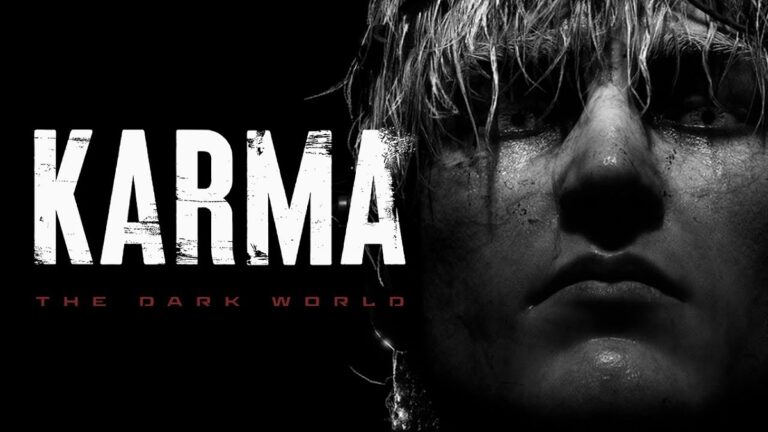Comparatively speaking, if Housemarque’s Dead Nation is George Romero’s Dawn of the Dead, then Konami’s sequel to 2009’s Zombie Apocalypse, subtitled Never Die Alone, is definitely Edgar Wright’s Shaun of the Dead. This comparison is solidified instantly as soon as you start your journey into yet another zombie apocalypse. Yeah, the tail-end part of that last sentence may arouse a sense of unwanted familiarity, possibly making one utter: “another zombie game?” As if the medium wasn’t already filled with enough of them, right? But fear not, what differentiates Zombie Apocalypse: Never Die Alone from other zombie titles out there– specifically other zombie-ridden twin-stick shooters– is the same thing that sets Shaun of the Dead apart from Romero’s classic film: humor. And trust me, the amount of humor here rivals the amount of zombies you’ll be faced with.
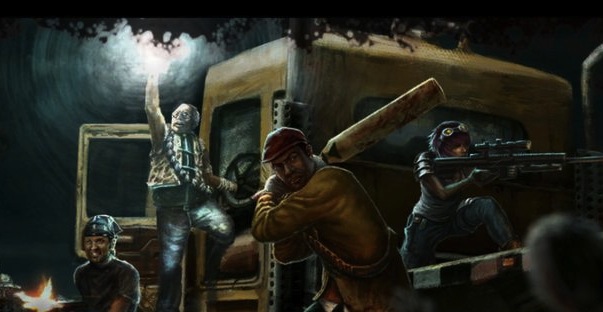
It’s not the type of comedy that quickly gets old, though. Instead, the main players in this particular zombie apocalypse, which has struck the once peaceful Helfaux Island, are the crucial reasons why this experience is as funny as it’s tense, or rather, the constant dialogue between them. You have the louth-mouth of this band of survivors, Jeremy, who’s a decorated pro-gamer and definitely the main catalyst of the game’s humor; the foul-mouth, British rapper, Def Money; a weapons specialist turned sniper, Alma; and lastly Father Bill, who’s carrying out the work of God with his trusty shotgun.
Throughout the entire twin-stick, top down shooter experience these four survivors will regularly exchange words with one another, making for some truly laugh-out-loud moments. Basically, what you get here is a parody of sorts of zombie entertainment in general– one standout moment was when Jeremy pointed out how there’s always a power plant involved whenever zombies are present.
I chose to play this game as the machine-gun wielding Jeremy from the getgo, but I often found myself cycling through each of the characters frequently throughout the game’s 10 levels that are tied together by the most basic of plots– though the story here isn’t what you should buy this game for anyway. Basically, the group of survivors have to get the hell out of Halfaux Island by using Def Money’s yacht, and in doing so they’ll go through many different environments that are all reasonably varied. And, of course, there’s the traditional power plant to paint the walls red in, which probably has to be my favorite level, albeit one of the ones that greatly displays one of the game’s flaws, but I’ll go into that in a bit.
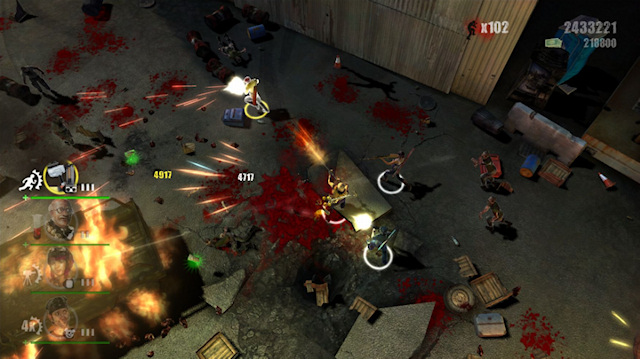
But let’s go back to the characters. They’re not only there to make the player laugh, but they each also have their own unique weapons and abilities that serve to complement one another– making online co-op sessions truly dependent on cooperation and overall group synergy. Yeah, I stuck to Jeremy almost the whole way through, but in many instances I had no choice but to swap to a different character to make use of their ability in order to help get me out of a tight spot or to help make some rather daunting scenarios a bit more manageable. I’ll illustrate this with one strategy I used often, especially in the later levels which get quite brutal.
In one particular level I was faced with hordes of zombies and a pair of the game’s form of boss zombies. To take on the standard hordes of undead I utilized Jeremy’s secondary attack which sees him throwing a cute bear that attracts the undead nearby, exploding in a beautiful blast of gore. Then I quickly swapped to Alma, who aside from having a neat sniper rifle, which may get a little getting used to since it’s the slowest weapon in the game, is also able to build a turret. So I planted said turret right in the middle of the area and swapped back to Jeremy to shoot down the zombies not in the turret’s immediate radius.
Then the boss zombies came in and I went on to utilize Jeremy’s special attack, which grants him a boost in speed and fire rate– the latter enhancement making his machine gun skills even more deadly (he is a pro-gamer, after all). Then I still had two hulking boss zombies to contend with and yet another incoming horde of regular zombies to kill, so I swapped to Def Money and put his secondary attack to good use– which brings out a stereo and makes all nearby zombies dance. I set all the dancing zombies ablaze with Father Bill’s molotov cocktails and then set my eyes solely on the bosses. But, being hurt, I needed to heal. And that’s where Father Bill came into play once again, who can be seen as the team’s medic. Fully healed, I then finished off the remaining boss zombies and went on to see the next level. (And in case you’re wondering, Def Money’s special ability has him whip out his cricket bat and swiftly move from enemy to enemy, bashing them in a free flow type fashion.)
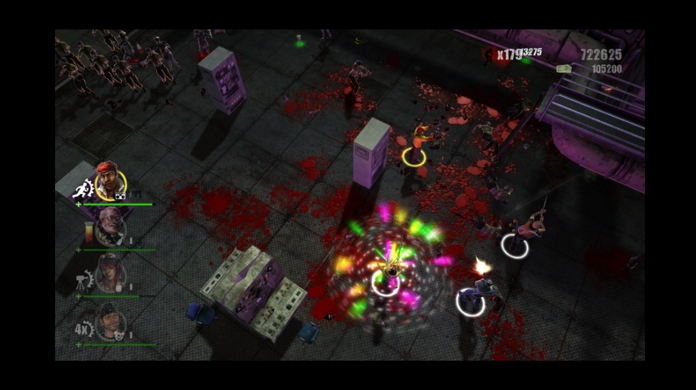
Even with such a strategy in play, I faced death many, many times. I found the difficulty to be a bit unbalanced at times, but not because of the overwhelming amount of zombies you’ll be faced with at a given time, but because (going back to a flaw I alluded to earlier) some areas, like the power plant, are way too dark for their own good. Instead of serving to enhance the game’s dreadful atmosphere, this choice to utilize darkness heavily in some areas serves to bring about an unneeded boost in difficulty. Sometimes you just can’t see what’s coming at you! And, as you could imagine, I found myself raging on more than one occasion as zombies would contantly swarm me and my fellow survivors.
Another downside is that melee attacks really don’t pack much oomph, and they’re rather useless. But you could upgrade said attacks, as well as everything else in each character’s repertoires. The way this works is that after each level you’re faced with an upgrade screen in which you could purchase available upgrades with your hard-earned cash which drop from enemies in the game. After purchasing say, an upgrade to your character’s special ability, you then have to actually perform the action the upgrade was designated for, in order for it to level up successfully. It may seem kind of odd to some, but hey, as long as it upgrades it’s all good. And trust me, you’ll need every upgrade you can afford.
Playing the game’s single player mode, I found my AI-controller partners to be quite smart, and they never did anything that was absurd. It also helps that you could swap characters on the fly, an ability that makes up for not having multiple weapons to choose from for each character. Want to be a bit more precise with your shots? Then switch to Alma. Or maybe you want to mow down enemies ala’ other arcade shooters? Then go with Jeremy (like I did). You also won’t find yourself bored at all, especially because you’ll always have hordes of zombies to take down as you go from level to level– levels alternating from standard, linear affairs, to timed arena-like ones which house environmental hazards that can be used against the undead (like a giant moveable donut in one early level).
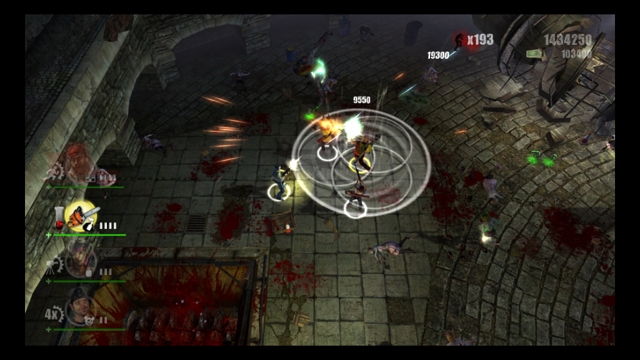
While the game may be over before you know it– clocking in at around 2 to 3 hours, depending on how many times you die since there’s no checkpoint system in place– there’s still plenty to keep you hooked after you see the ending. Just by being a top-down arcade shooter, replayability is instantly warranted, with high scores to top on a level by level basis and speed runs possibly being something you would want to do after you clear the game initially. Also, each level has its own group of secondary challenges to tackle, like saving other survivors (in which you have to slap some sense into them), achieving a certain number of kills within a given time limit, and in some cases: not dying. Some are harder than others, but each serves to extend your time with the game.
Then you have co-op, of course, which is a route that may be more appealing than single-player, since you’ll have actual people to work together with. But this means that each person will have to make sure to put their respective character’s ability to good use, since you won’t be able to swap characters like you could in single-player. Cooperation is definitely key here, and a lack of it will result in many deaths, and many insults!
Lastly, you have survival mode which is unlocked after you beat the game once. This mode is just as its name suggests: you have to survive for as long as you can, fending off relentless waves of zombies. This may not be something for those already irked by the main campaign’s difficulty, but it’s definitely something that adds even more replay value to the overall package. And personally, I love survival modes, especially when zombies are the enemies. What I really don’t think I’ll love is the Blackout mode which pits you in complete darkness. Yeah, I’ll probably end up breaking my controller if I partake in said mode.
———————————————————————
Never Die Alone is a satisfying sequel to the original Zombie Apocalypse. It surpasses it in almost every regard and in doing so also offers a wholly humorous take on the zombie apocalypse, one rife with comedy instead of the gloom and doom many zombie titles are filled with. Yeah, the world around the game’s four main characters is going straight to hell, but each one of them is having a good ol’ time trying to survive. It doesn’t take itself too seriously, and that’s what denies it entry to the “generic zombie game club.” If you enjoy funny takes on the zombie apocalypse, like Dead Rising, then you’ll definitely get a kick out of Never Die Alone. Certain flaws may hold it back from joining the ranks of Dead Nation, but it’s still a really enjoyable zombie shooter that sadly may get ignored admist all the big triple-A titles hitting around this time.
 (8 / 10)
(8 / 10)
Great
 (8 / 10)
(8 / 10)
 JBoc924
JBoc924